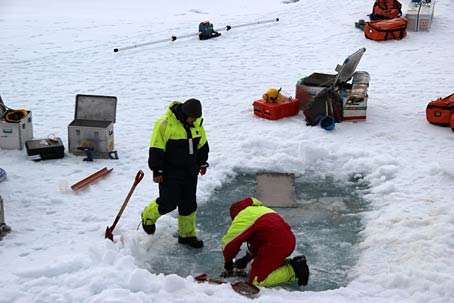Unlocking the secrets of drifting, crashing, moving ice

Arctic offshore engineering scientists from the Norwegian University of Science and Technology (NTNU) and colleagues from nine international universities and companies and the Swedish Polar Research Secretariat will head out on Monday, 19 August on a two-week research cruise to the waters off the northeastern coast of Greenland.
The multinational group will leave from Longyearbyen, Svalbard on the Swedish polar icebreaker Oden, and will measure and quantify a variety of aspects of sea ice, icebergs and their interaction with the ship. The group will return to the area that they studied last year, which will enable them to retrieve underwater moorings that have been busily collecting ice and ocean current data for the last year.
Five marine mammal researchers will also be aboard the vessel, where they will conduct acoustic research and combine conventional marine mammal observations with more high-tech approaches.
"The offshore area northeast of Greenland is a very interesting place for us, because it is a place with multiyear ice and with quite heavy drift of sea ice and icebergs," says Raed Lubbad, cruise leader and an associate professor based at SAMCoT, NTNU's centre for research-based innovation on Sustainable Arctic Marine and Coastal Technology. "It's also an area that we couldn't otherwise get to without a proper icebreaker, like Oden."
A year's worth of data
One of Oden's most important tasks is also seemingly its simplest: the retrieval of four underwater moorings that were deployed last year, when the first OATRC came to the region. These moorings are loaded with instruments, including upward-looking sonar and Acoustic Doppler Current Profilers (ADCP), which measure water currents.
While it might seem easy to pluck the moorings up out of the Greenland Sea, it could be anything but, Lubbad says. The ship sends a signal to the moorings that tells them to release their coupling and pop up from where they have been anchored underwater – but if there is too much ice over the area where the moorings are located, it will be challenging to find them, he said. Or the ice cover may prevent the ship from being able to physically retrieve the instruments.
"These are very important," Lubbad says. "They give us long time series data on ice thickness, drift and sea currents that enable us to quantify the physical environment."
Among the most interesting data from the moorings is that concerning the frequency and thickness of ice ridges. An ice ridge forms when two ice sheets are pressed against each other and consists of accumulated pieces of broken ice, so that its total thickness is much greater than that of the original ice.. "These ice ridges typically produce the highest loads on structures," Lubbad says. "Knowing how thick these ridges are, how fast they drift and how frequent they are is very important for the design of ships and floating structures."
Ground-truthing remote sensing
The researchers will also employ a variety of technologies to quantify the ice around the ship and icebergs that are in the vicinity of the ship. In addition to using electromagnetic sensors to continuously measure the ice thickness around the ship itself, Lubbad says the researchers will use near real-time satellite images to look for icebergs and then ground-truth the icebergs that they identify.
In this case, "ground-truthing" an iceberg means visiting it by helicopter and using a remotely piloted aircraft system (RPAS) to make a three-dimensional image of the iceberg, including its size and thickness. At the same time, researchers will use a remotely operated underwater vehicle (ROV) to collect the same information about the underside of the iceberg.
Finally, they'll deploy a weather station atop the berg, along with an ACDP and hydrophones so that marine mammal biologists can listen for animals that might be in the vicinity of the berg. These instruments will be left on the iceberg for several days before they are retrieved, but the berg will also be instrumented with a tracker that will report on the iceberg's movements over the next four months, Lubbad said.
Searching for marine mammals
This is second year a team of marine mammal biologists will participate in the cruise. They will benefit not only being able to study the relatively remote area off of the northeast coast of Greenland but from working with ice engineers and scientists in the identification of ice features that can be important habitat for marine mammals such as polar bears.
"We're very excited about this," said Jürgen Weissenberger, a Statoil biologist who is heading up the marine mammal group.
The biologists will also use hydrophones to listen for animals underwater, as well as an infrared camera, which will enable to them to find animals that otherwise might be difficult to detect visually.
A multinational group
The 32 cruise participants hail from 14 countries and come from NTNU, the University Centre in Svalbard (UNIS), TU-Delft in the Netherlands, Saint Petersburg State University, the University of Barcelona, the University of Alaska-Fairbanks, the Norwegian oil company Statoil, Maritime Robotics, ASL Environmental Sciences in Canada, and the Ship Modelling and Simulation Centre AS in Norway.
The cruise was made possible in part by a memorandum of understanding between NTNU and the Swedish Polar Research Secretariat, and is being conducted with support from Statoil and in collaboration with the Swedish Maritime Administration, which owns Oden.
Provided by Norwegian University of Science and Technology



















